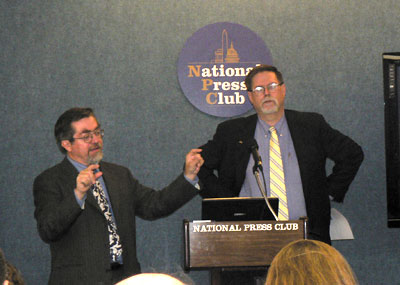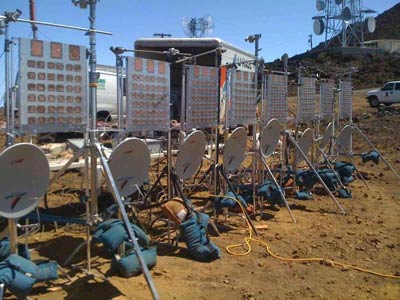A step forward for space solar powerby Jeff Foust
|
| “What we achieved was a first-of-its-kind long-range test of solar-powered wireless power transmission technologies, essentially all of the major system elements that would need to be in a space solar power system,” said Mankins. |
The demonstration came about in a rather unconventional way. John Mankins, chief operating officer of Managed Energy Technologies and a long-time advocate of SSP, said shortly after an October 2007 press conference last year where the National Space Security Office released its report on SSP, he got a call from Impossible Pictures, a British film production company working with the Discovery Channel on a new series. Were there any experiments related to SSP that might make for good TV? By January Mankins’ company had signed a contract to perform one such experiment, the power-beaming demonstration.
“What we achieved was a first-of-its-kind long-range test of solar-powered wireless power transmission technologies, essentially all of the major system elements that would need to be in a space solar power system,” Mankins said.
The test was not the first demonstration of long-range power beaming: in 1975 an experiment at the NASA Deep Space Network station in Goldstone, California, also transmitted power, but over a distance of only about 1.5 kilometers. That test also used about 1,000 times the power of the May experiment, enough to illuminate a set of floodlights, Mankins said. “We were working with a smaller budget, a shorter time, and in the context of the FAA,” which put restrictions on power levels so as not to interfere with aircraft communications. The May test transmitted at only about 20 watts, using a phased-array system developed by a team at Kobe University in Japan and Texas A&M University in the US.
The show’s producers, Mankins said, were a little concerned that the experiment might not be interesting enough. “They were worried at the beginning, and said, ‘This is just electronics, is it really going to be interesting? Maybe we need to script in some problems,’” he recalled. That was hardly a concern. “We had no amounts of trouble and grief and problems.”
And, in an effort to build drama, those problems, most notably difficultly keeping the beam properly aligned, as well as limited fuel for a helicopter flying through the beam to measure its strength, were played up in the show (which actually makes no mention of the 148-kilometer test, instead declaring victory when the helicopter, low on fuel, detects the beam at a distance of nearly 100 kilometers.) Still, that was minor to what could have been done to create artificial drama: in another segment of the show, the ability of a solar cell fitted with a Fresnel lens concentrator to generate more power than one without it in near-space conditions was tested by placing them in a balloon (provided by JP Aerospace) and flying it to an altitude of 30 kilometers, when they could have been tested more effectively—but less photogenically—in a lab.
The nature of this experiment led some to question whether it was a just a stunt: good TV drama, but doing little to push the frontiers of SSP technology. Mankins disagreed. “The reason why it’s not a stunt is that these are the right component technologies and the right kind of system architecture end-to-end,” he said. The system, for example, transmitted at 2.45 GHz, one of the most likely frequencies that an actual SSP system would use since the atmosphere is transparent at that frequency. “It was strictly a matter of budget that kept it from being a higher-powered test.”
 John Mankins (left) discusses his SSP experiment while Mark Hopkins of the NSS looks on during the September 12 press conference in Washington. (credit: J. Foust) |
Studies and lobbying
Something the Discovery Channel “Project Earth” show (which aired Friday night) did not touch upon is what’s next for SSP. At the press conference, though, Mankins outlined what he thinks should be done over the next several years to make continued progress on SSP. That work should begin with a “quick look” study and some experiments to validate key SSP technologies over the next few years, at a total cost of no more than $100 million.
| The nature of this experiment led some to question whether it was a just a stunt: good TV drama, but doing little to push the frontiers of SSP technology. “The reason why it’s not a stunt is that these are the right component technologies and the right kind of system architecture end-to-end,” Mankins said. |
That would be followed in six to seven years with flight tests of SSP in low Earth orbit for under $1 billion. In about ten years, and for no more than $10 billion, “you can get to a legitimate ‘pilot plant’ in geostationary Earth orbit,” according to Mankins, along with demonstrations of key space transportation technologies needed to make SSP economically viable. “Within 15 years, we believe you can get to actual deployment of operational systems.”
While that’s an ambitious schedule, Mankins dismissed concerns of “analysis paralysis” linked to doing yet another study of the feasibility of SSP, as he proposed. “The storyline is, ‘We don’t need more studies, let’s just do hardware,’” Mankins said. “In fact, no end-to-end studies have been done since 1995–1997. They absolutely need to be done to get at what are the real parameters we have to achieve.”
Such efforts, though, are likely beyond the budgets of the Discovery Channel and other networks (not to mention that doing studies hardly makes for the most scintillating television), requiring funding from other sources, most likely the federal government, which is not currently funding any SSP-related research. A variety of government agencies, Mankins said, could step forward to support this, from the Defense Department to the Energy Department. “The $100 million could come from a variety of places, but the key thing is to have it actually focused on these problems,” he said.
“The United States is by far the world’s greatest space power,” said Mark Hopkins, senior vice president of the NSS, “and yet we’re not spending any money in this country on space solar power.” That’s not the case in Europe and Japan, where there is money being spent, if only on a small scale, on SSP. “The situation is ridiculous.”
One person working to try and make the case for SSP on Capitol Hill is Paul Rancatore. Earlier this year Rancatore ran for Congress from Florida’s 15th district, in the state’s “Space Coast” region and home to many people who work at the Kennedy Space Center. Rancatore made mention of SSP in his campaign, calling it “an economic generator not seen since the Apollo program” and winning the endorsement of Apollo 11 Buzz Aldrin. However, he lost the Democratic primary last month.
Rancatore is now spending time meeting with members of Congress and their staffs, primarily with the House Committee on Energy and Commerce and the Select Committee on Energy Independence and Global Warming, on the issue of SSP. “Energy is probably the biggest issue facing the country as well as the world,” he said, requiring both short- and long-term solutions. SSP, he said, solves three major issues in the US today: employment, particularly in high-technology areas; energy independence; and foreign policy.
| “The United States is by far the world’s greatest space power,” said Mark Hopkins, senior vice president of the NSS, “and yet we’re not spending any money in this country on space solar power.” |
Right now, Rancatore said he’s working to “educate members about what space-based solar power can do for our country, create that dialogue, and possible create a ‘space-based solar caucus’ within Congress for them to fully understand the ramifications for our country and the world and start get members involved.” In an interview after the press conference, he said he’s met with Congressman Ed Markey (D-MA), who chairs the global warming committee, about this issue. Rancatore said he’s yet to identify a member willing to champion this issue in Congress, but expects to make progress on that front, including establishing the caucus, when a new Congress convenes in January. He added that he’s reached out to the campaigns of John McCain and Barack Obama on this subject as well.
Some of that rhetoric being used to win over members of Congress was trotted out at the press conference as well. “The potential of space solar power is so large that, if it works out, it would transform the American economy to a much greater extent than the auto industry did in the early part of the 20th century,” said Hopkins, who added that SSP could allow the US to stop spending hundreds of billions of dollars a year to import energy, some of it from countries unfriendly to the US.
That’s the long-term goal, but for now the focus is on near-term incremental progress. “What we think we’ve done is to demonstrate that progress is possible,” Mankins said. “It’s possible in a short time and it’s possible at a reasonable budget.”
